By James Stevens Curl
A new book about the discovery of classical sculptures and frescoes is itself a real treasure
The Legacy of Vesuvius: Bourbon Discoveries on the Bay of Naples
edited by Michael L. Thomas
(New York: Scala Arts Publishers Inc., an imprint of B.T. Batsford Holdings Ltd., 2024)
ISBN: 978-1-78551-573-6 (hardback)
184 pp., many col. & b&w illus.
£45.00
This splendid tome, produced to accompany a major exhibition at the Meadows Museum, SMU, Dallas, Texas (15 September 2024 to 5 January 2025), and published in association with the Custard Institute for Spanish Art and Culture, contains several essays dealing with the spectacular finds discovered as a result of the excavations on the Bay of Naples carried out under the ægis of the Bourbon monarchs of Spain.
The enormous tragedy that befell the Bay area in AD79, paradoxically, preserved much to enlighten us about the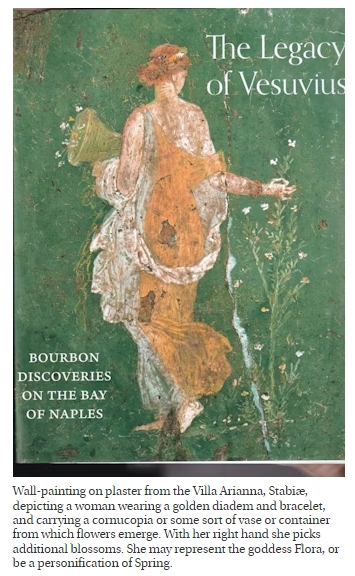 daily life and culture of prosperous Roman towns in the reign of Emperor Titus (r.AD79-81), and although we have a detailed description of the eruption by “Pliny the Younger” (Gaius Plinius Cæcilia Secundus [AD61/2-c.113]), much of how we perceive that fragment of Roman civilisation that once thrived in Pompeii, Herculaneum, and Stabiæ is heavily influenced by eighteenth-century concerns and interpretations. The authors of this book highlight the power of patronage and argue that the legacy that has come down to us is as much Bourbon as it is Vesuvian, as much a product of relatively modern thinking as it is ancient. Perhaps the most important aspect of the exhibition is that it reveals a great deal about how the cognoscenti of the eighteenth century received and processed new knowledge of the ancient world revealed through excavations, and how this phenomenon propelled the acceptance of Neo-Classical Taste, thereby acting as a catalyst for a felicitous period in the history of European architecture, art, and landscape.
daily life and culture of prosperous Roman towns in the reign of Emperor Titus (r.AD79-81), and although we have a detailed description of the eruption by “Pliny the Younger” (Gaius Plinius Cæcilia Secundus [AD61/2-c.113]), much of how we perceive that fragment of Roman civilisation that once thrived in Pompeii, Herculaneum, and Stabiæ is heavily influenced by eighteenth-century concerns and interpretations. The authors of this book highlight the power of patronage and argue that the legacy that has come down to us is as much Bourbon as it is Vesuvian, as much a product of relatively modern thinking as it is ancient. Perhaps the most important aspect of the exhibition is that it reveals a great deal about how the cognoscenti of the eighteenth century received and processed new knowledge of the ancient world revealed through excavations, and how this phenomenon propelled the acceptance of Neo-Classical Taste, thereby acting as a catalyst for a felicitous period in the history of European architecture, art, and landscape.
In the early part of the 1700s, Friedrich August I (r.1694-1733 as Elector of Saxony and 1697-1704/1709-33 as Augustus II, “The Strong”, King of Poland) established the celebrated porcelain manufactory at Meißen, and when Charles of Bourbon (Charles VII of Naples and V of Sicily [r.1735-59]) took as his Queen Augustus’s granddaughter, Maria Amalia of Saxony (1724-60), in 1738, she brought porcelain-making to Capodimonte in 1743. This factory produced porcelain objects that were “imbued with a cultural and political cachet”, and, combined with the excavations around Vesuvius, served to demonstrate permanence, power, and prestige to be associated with youthful monarchs as representatives of a recently installed dynasty.
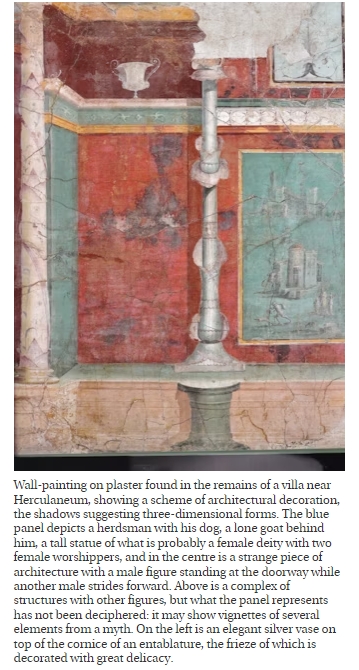 The fragments of interior decorations that had miraculously survived the catastrophe had an enormous influence on Neo-Classical architecture once they were disseminated by means of publications and seen by wealthy young men enjoying that essential part of a gentleman’s education, the Grand Tour. Indeed, so sensational were the discoveries that the centre of gravity of the Grand Tour shifted southwards to the Bay of Naples. The excavations at Herculaneum, especially the discovery of the Villa of the Papyri, brought a lost world back to life with an immediacy, for this lavish villa suburbana housed a library containing in excess of 1700 papyrus scrolls (some of which, thanks to modern technology, are beginning to reveal their contents to us) and an amazing collection of sculpture: the Bourbon-financed excavations unearthed 51 bronze and 24 marble statues, all of remarkably fine quality, the themes of which have exercised scholars immersed in what kind of intellectual paths a cultivated Roman would have explored when enjoying civilised otium, or leisure time. Among the sculptures is a bronze statue of a runner, the eyes of which are inset with bone and stone, with white irises and black pupils, and the curly hair is shown in extraordinary detail: although it (one of a pair) was probably made in a Campanian workshop some time in the first century BC to the middle of the first century AD, stylistically it was profoundly influenced by Grecian exemplars.
The fragments of interior decorations that had miraculously survived the catastrophe had an enormous influence on Neo-Classical architecture once they were disseminated by means of publications and seen by wealthy young men enjoying that essential part of a gentleman’s education, the Grand Tour. Indeed, so sensational were the discoveries that the centre of gravity of the Grand Tour shifted southwards to the Bay of Naples. The excavations at Herculaneum, especially the discovery of the Villa of the Papyri, brought a lost world back to life with an immediacy, for this lavish villa suburbana housed a library containing in excess of 1700 papyrus scrolls (some of which, thanks to modern technology, are beginning to reveal their contents to us) and an amazing collection of sculpture: the Bourbon-financed excavations unearthed 51 bronze and 24 marble statues, all of remarkably fine quality, the themes of which have exercised scholars immersed in what kind of intellectual paths a cultivated Roman would have explored when enjoying civilised otium, or leisure time. Among the sculptures is a bronze statue of a runner, the eyes of which are inset with bone and stone, with white irises and black pupils, and the curly hair is shown in extraordinary detail: although it (one of a pair) was probably made in a Campanian workshop some time in the first century BC to the middle of the first century AD, stylistically it was profoundly influenced by Grecian exemplars.
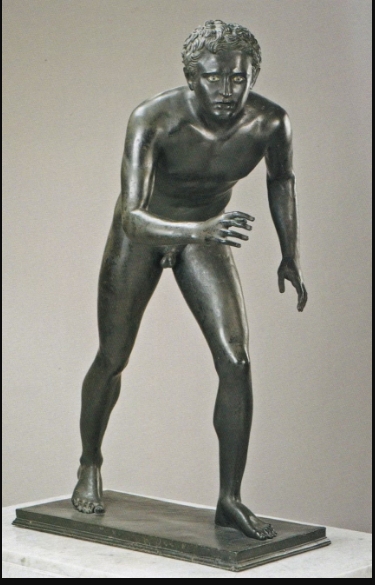
Astonishingly well preserved were the six scenes painted on the walls of the ekklesiasterion, a large room in the Temple of Isis, Pompeii. These scenes show in some detail aspects of what would have been familiar to devotees of Isis and Serapis, not least the startling figure of a priest wearing the jackal-head of the God Anubis. It is perhaps not as well known as it should be how important were the Egyptian cults of Isis and Serapis/Osiris from the time of Octavian’s triumph over Mark Antony and Cleopatra at Actium: in fact one of the largest and most lavish of temples in Imperial Rome was the Isæum Campense in Rome itself, a vast complex, part of which now lies under the church of Santa Maria sopra Minerva, near the Pantheon, and the sanctuary of the Serapæum, at the end of the temple opposite the Isæum, is buried beneath San Stefano del Cacco. That great temple, and many of the artefacts that once embellished it, are described and illustrated in my The Egyptian Revival (Routledge, 2005) together with an analysis of how Isis has survived in different guises to the present time. Indeed, I have had the temerity to suggest that Christianity owes as much to the Nile as it does to the Jordan, and that the absorption of Alexandrian cults into Europe during the Roman Empire played no small part in the marvellous biographies of Christian Saints. Enthusiasts wishing to pursue these extraordinary matters are referred to that great compendium by Sabine Baring-Gould (1834-1924), The Lives of the Saints, published in Edinburgh by John Grant in 16 volumes in 1914.
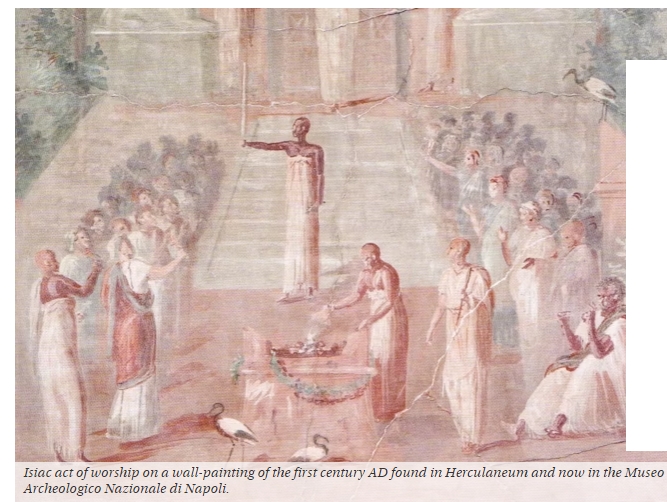 At Herculaneum was discovered in 1745 an extraordinarily vivid depiction of an Isiac ceremony: the central figure before the doorway is a priest reverently holding a sacred vessel, and on either side of him figures shake sistra, or rattles, the figure on his left, obviously with a dark skin, wearing very un-Roman clothing. The palm-trees, ibises, and sphinxes set the Egyptianising theme. A priest with a branch gesticulates towards worshippers on either side, while another priest tends an altar. And one or the most noble buildings in Pompeii, occupying an important central site, was the Temple of Isis referred to above. Its discovery was recorded and illustrated in Campi Phlegrael: Observations on the Volcanoes of the Two Sicilies (1776) by Sir William Hamilton (1731-1803), who had been appointed Envoy-Extraordinary to the Spanish Court at Naples in 1764, and who became a great collector of art and antiquities, especially of vases thought to be “Etruscan” but now known to be Greek. Later, of course, he is perhaps better known as the husband (from 1791) of Emma Lyon, aka Hart (1765-1815), who was originally acquired by Hamilton as ‘a modern piece of virtù’ capable of striking “attitudes” based on images of Classical female figures, so was added to his collection as a kind of animated statue. Later, in 1798, of course, she became the mistress of Horatio Nelson (1758-1805), fresh from his spectacular victory over the French at the Battle of the Nile (aka Bay of Aboukir) in that year.
At Herculaneum was discovered in 1745 an extraordinarily vivid depiction of an Isiac ceremony: the central figure before the doorway is a priest reverently holding a sacred vessel, and on either side of him figures shake sistra, or rattles, the figure on his left, obviously with a dark skin, wearing very un-Roman clothing. The palm-trees, ibises, and sphinxes set the Egyptianising theme. A priest with a branch gesticulates towards worshippers on either side, while another priest tends an altar. And one or the most noble buildings in Pompeii, occupying an important central site, was the Temple of Isis referred to above. Its discovery was recorded and illustrated in Campi Phlegrael: Observations on the Volcanoes of the Two Sicilies (1776) by Sir William Hamilton (1731-1803), who had been appointed Envoy-Extraordinary to the Spanish Court at Naples in 1764, and who became a great collector of art and antiquities, especially of vases thought to be “Etruscan” but now known to be Greek. Later, of course, he is perhaps better known as the husband (from 1791) of Emma Lyon, aka Hart (1765-1815), who was originally acquired by Hamilton as ‘a modern piece of virtù’ capable of striking “attitudes” based on images of Classical female figures, so was added to his collection as a kind of animated statue. Later, in 1798, of course, she became the mistress of Horatio Nelson (1758-1805), fresh from his spectacular victory over the French at the Battle of the Nile (aka Bay of Aboukir) in that year.
When the Temple of Isis at Pompeii was uncovered, its wall-paintings, sculptures, and furnishings fuelled the production of Isiac-inspired porcelain alongside the more Classically themed objects emanating from the Real Fabbrica Ferdinandea di Napoli. Among my own favourites is the Gruppo di Iside, a marvellous pasticcio (a term wholly misunderstood by Modernists, and used corruptly by them to sneer at anything of which they disapprove) of Antique elements drawn from a variety of sources: the central figure of the great Goddess Isis was modelled on the statue that stood in the portico of the Pompeian Temple, excavated in 1766. The sculptor was Filippo Tagliolini (1745-1809), and it depicts a ritual as imagined by the artist: it was intended as part of the centrepiece of a table-setting that included a model of the Temple of Isis itself, a procession of figures taking part in a sacrifice, and Egyptanising candlesticks. It was commissioned by Queen Maria Carolina of Naples (r.1768-1806 — who was a daughter of the Holy Roman Empress, Maria Theresa [r.1745-80], and therefore a sister of the Queen of France, Marie Antoinette [r.1774-92]) for another sister, Maria Amalia, Duchess of Parma (r.1769-1802). It is a pity the various parts of this stupendous dessert have been dispersed: the group illustrated is now in the Museo e Real Bosco di Capodimonte, Naples, but the Temple is in a private collection and other pieces appear to have vanished.
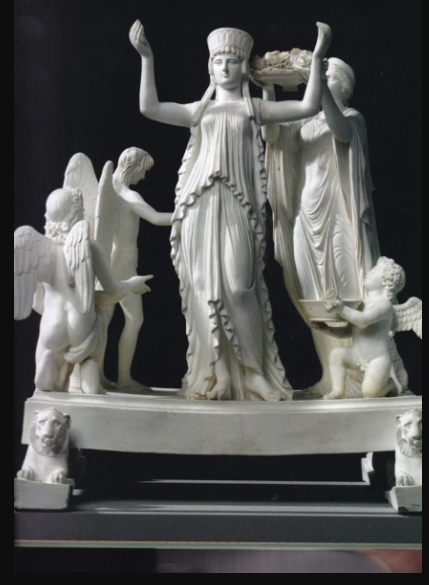
All in all, this beautifully produced and profusely illustrated book contains a wealth of glorious objects and images, possession of it being the next-best thing to visiting the exhibition in person. The illustrations are clear and the volume contains a useful bibliography: the editor, who also curated the exhibition, is to be warmly congratulated, as are the learned contributors whose essays add lustre to the production, although I would have welcomed years of birth and death of personages being added, with years of reigns, all included in the index to avoid littering the texts with dates.
But I must again make one grumble: why are so many books printed in China nowadays, when so many competent printers in these islands (and in the USA) could do the job, some of whom are crying out for work?
First published in The Critic







